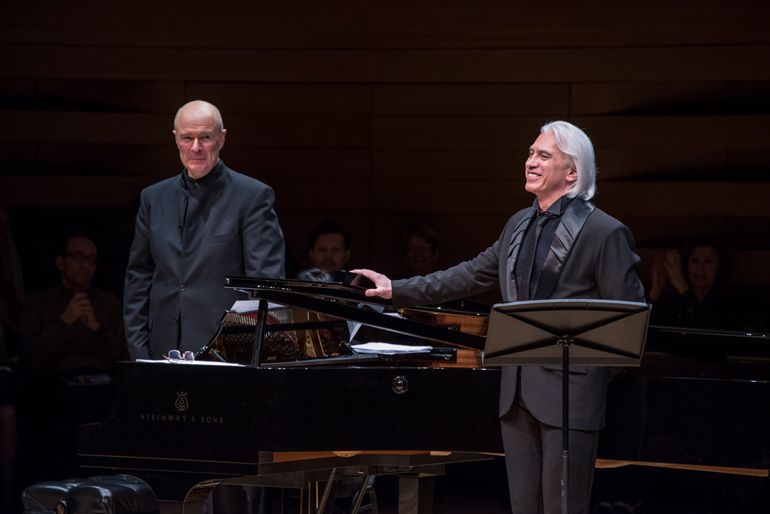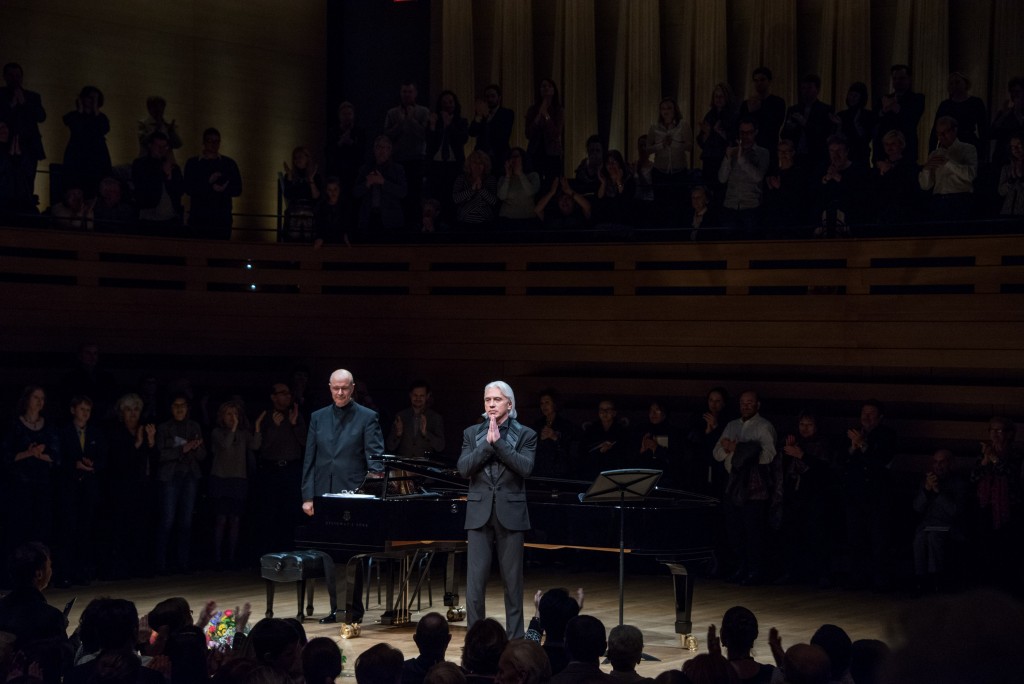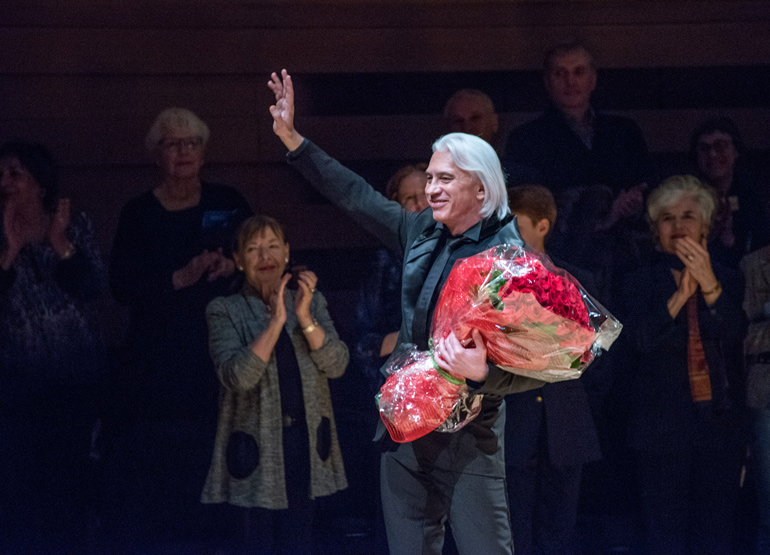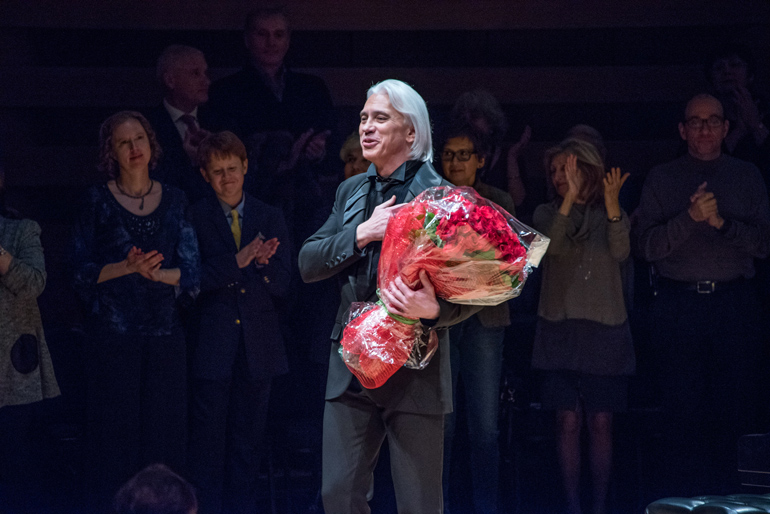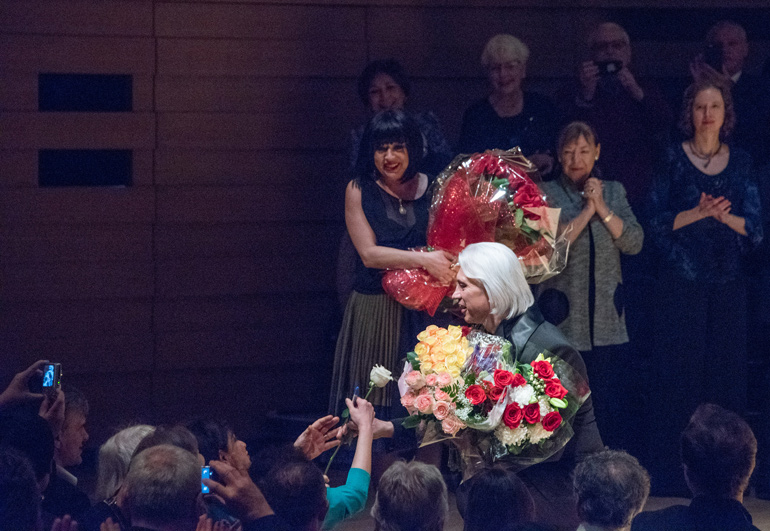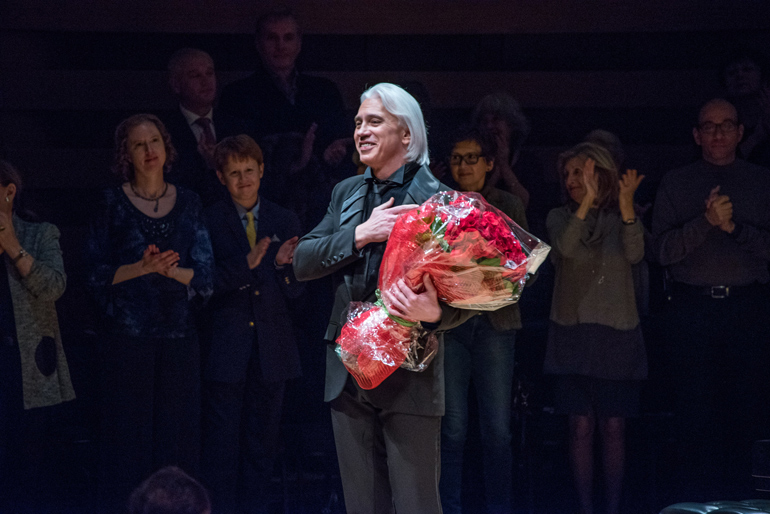
Dmitri Hvorostovsky (baritone) and Ivari Ilya (piano) at Koerner Hall. Sunday, Feb. 21.
Allow me to borrow a famous term from the 1960’s Hippie Counterculture – last evening’s recital by Russian baritone Dmitri Hvorostovsky at Koerner Hall was the veritable Love-In.
From the first note to the last of a generous program, the audience was firmly on the side of “Dima” as the singer is affectionately called by his friends and fans. They were there to of course enjoy the spectacular vocalism of a great artist, but also to be there to help him celebrate an important moment in the baritone’s life, to bear witness in his triumph overcoming huge medical odds, to once again stand in front of an audience, to do what he does best.
For those not familiar with his health issues – last spring, Hvorostovsky was diagnosed with a brain tumour. It led to cancellations of his engagements to receive treatment over the summer and the fall. He came back to the Met in October to sing di Luna in Il Trovatore, one of which was shown in the series Met in HD. I went to the show and found him in excellent voice. Then he cancelled the rest of the run to return to treatment. So his appearance here on this recital tour is very special, with only three stops – Carnegie, Toronto and Chicago.
It was the hottest ticket in town. The 1,135 seat Koerner Hall was jammed to the rafters – the demand was so great that they had to put two rows of stage seating. Even then, there were sad faces of ticketless fans milling about the entrance before the show begging for a ticket, any ticket. I come across this scene when I travel to places like Munich and London and New York, but Toronto? Once in a blue moon….
The atmosphere inside was festive, with lots of Russian speakers in the audience, many bearing bouquets of flowers for their beloved Dima. Saw lots of friends and colleagues there, plus many “in the business” including present and former singers, impresarios and intendants the likes of Canadian Opera Company General Director Alexander Neef.
Hvorostovsky walked out to sustained, thunderous ovations. Was I in a rock concert??? Looking handsome and debonair as usual, perhaps just a tad trimmer than before in a tight-fitting suit. He got down to business with five Glinka songs. He used the score on a music stand, referring to it frequently. I’m more familiar with the operas of Glinka than his songs – it was a great pleasure to discover the wealth of melodic inspiration, particularly Somneniye (Doubt) with its Bellini-like, Italian bel canto melody, absolutely gorgeous! Vocally, Hvorostovsky began carefully, the first two songs sung at mezza forte. By the third song, Ne govori, chto serdtsu bol’no, his full palette of tone colours appeared for the first time.
This was followed by six Rimsky-Korsakov songs. By now, Hvorostovsky was fully warmed up. He sang with a surfeit of power, with his distinctive timbre, phenomenally long breath-line, a keen sense of drama, all backed up with a formidable technique. One couldn’t help but be amazed that after what he went through medically, he still had the strength to do a generous program such as this. Physically there were moments when he looked oddly stiff onstage, and there were fleeting moments of a look of grim determination on his face. Perhaps there was a slight diminution of power, and his lowest notes (especially early in the recital) weren’t as firmly supported as before. But no matter how you look at it, a Hvorostovsky at 90 or 95% is still head and shoulders above many other singers.
The second half was on more familiar grounds, opening with four famous songs by Tchaikovsky, set to text by Pushkin and Tolstoy. At 53 and 26 years after winning Cardiff in 1989, it’s remarkable that Hvorostovsky can still offer such powerful vocalism in Blagoslovlyayu vas, lesa (I bless you, forests). The drama in Solovey (Nightingale) was palpable. My favourite of this group was the stunningly beautiful Sred’ shumnogo bala, sluchayno (Amid the din of the ball). Hearing him sing these songs make me want to go to the Met next season to hear his Onegin once more…
The final group was a surprise – five Richard Strauss songs. This was the first time I’ve heard Hvorostovsky sing Strauss. He certainly has the refulgent tone to do Zueignung and Cacilie justice, even though he had moments of insecurity with the text in both songs. He also suppressed the consonants in his German, but that’s a minor quibble. His Morgen, as expected, was beautiful. As you can imagine, the audience just adored him. After countless ovations, he rewarded the sold out house with the Neapolitan song, Passione, the only Italian piece in the whole evening. Still, the audience wouldn’t let him go, and he sang, a capella, a Russian folksong. I have no idea what is the name of the song, but I was told that it has to do with nature.
Through it all, the pianist Ivari Ilya, a long-time collaborator of Hvorostovsky, offered the most solid support. Mr. Ilya is of the old school of Russian pianists, playing with a grand style, complete with elegant and florid arm and finger gestures that are positively mesmerizing. Formidable technique is a given, of course. I found myself watching him almost (but not quite!) as much as the singer. The first two songs, I thought Mr. Ilya was surprisingly loud, louder than I thought a collaborative pianist should be. Starting with the third or fourth song and definitely by the end of the Glinka group, Ilya’s playing was much softer, more subtle, with lighter fingering where appropriate. I think it was likely intentional, to offer more support for the singer when he’s warming up, a brilliant strategy.
Perhaps it’s my imagination, but I find Hvorostovsky’s artistry has deepened since his illness. I don’t say that lightly. I’ve heard him close to twenty times over the years in opera, concerts and recitals, including his first Roy Thomson Hall appearance way back around 1992. I remember it clearly. I think it was on a Tuesday. I had the flu while teaching out-of-town and got out of my sickbed, drove to Toronto for the concert – nothing was going to stop me! Always a great singer, but now I think Hvorostovsky imbues the text with greater meaning. Certainly a near-death experience will do that to any artist! I wish him many more years of health, so we can continue to enjoy the artistry of this great singer.
#LUDWIGVAN
Want more updates on Toronto-centric classical music news and review before anyone else finds out? Get our exclusive newsletter here and follow us on Facebook for all the latest.

